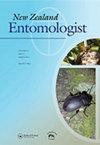Subterranean nesting behaviour in response to soil moisture conditions in the southern ant, Monomorium antarcticum Smith (Hymenoptera: Formicidae)
IF 0.4
4区 农林科学
Q4 ENTOMOLOGY
引用次数: 1
Abstract
ABSTRACT The New Zealand endemic southern ant (Monomorium antarcticum) excavates subterranean nests in various soil types, with brood distributed throughout excavated cavities connected by tunnels. Because cavities are often constructed near the soil surface, variation in rainfall patterns will affect soil moisture, and potentially lead to regular flooding of cavities. We examined how M. antarcticum make colony emigration decisions as soil moisture changes over time, and investigated how colonies manage brood underground during simulated rainfall events. We show that colonies will emigrate to wetter soil and excavate a new nest when their environment becomes too dry. After we add water to the surface of the nest (i.e. simulate rainfall), workers transport brood from cavities into tunnels, and move them back into the cavities as soon as the ‘rain’ stops. Workers tend to prioritise moving brood from cavities with higher densities of brood, regardless of the depth of the cavity from the soil surface. We discuss how the ability to emigrate in response to changes in soil environment, and to effectively respond to unpredictable rainfall/flooding events, can help us understand how this species persists in a wide-range of habitat types.南极单蚁对土壤水分条件的地下筑巢行为(膜翅目:蚁科)
摘要:新西兰特有的南方蚂蚁(Monomorium antarcticum)在各种土壤类型中挖掘地下巢穴,巢穴分布在通过隧道连接的洞穴中。由于洞穴通常建在土壤表面附近,降雨模式的变化会影响土壤湿度,并可能导致洞穴定期泛滥。我们研究了南极M.antarcticum如何随着土壤湿度的变化而做出群落迁移决定,并研究了在模拟降雨事件中群落如何管理地下繁殖。我们表明,当环境变得过于干燥时,群落会迁移到更潮湿的土壤中,并挖掘出一个新的巢穴。在我们向巢穴表面加水(即模拟降雨)后,工作人员将幼崽从洞穴中运到隧道中,并在“雨”停止后将它们移回洞穴。工人们倾向于优先将幼崽从密度较高的洞穴中转移出来,而不管洞穴离土壤表面的深度如何。我们讨论了移民应对土壤环境变化的能力,以及有效应对不可预测的降雨/洪水事件的能力,如何帮助我们了解该物种如何在各种栖息地类型中持续存在。
本文章由计算机程序翻译,如有差异,请以英文原文为准。
求助全文
约1分钟内获得全文
求助全文
来源期刊

New Zealand Entomologist
ENTOMOLOGY-
CiteScore
0.70
自引率
33.30%
发文量
3
审稿时长
>12 weeks
期刊介绍:
The invertebrate diversity of New Zealand is of great interest worldwide because of its geographic isolation and geological history. The New Zealand Entomologist plays an important role in disseminating information on field-based, experimental, and theoretical research.
The New Zealand Entomologist publishes original research papers, review papers and short communications. We welcome submissions in all aspects of science regarding insects and arthropods in a New Zealand or Australasian setting. The journal’s subject matter encompasses taxonomy, phylogenetics, biogeography, biological control and pest management, conservation, ecology and natural history.
The journal is the official publication of the Entomological Society of New Zealand. Papers published or submitted elsewhere for publication will not be considered, but publication of an abstract or summary elsewhere (e.g. conference proceedings) does not preclude full publication in the New Zealand Entomologist. Accepted papers become copyright of the Entomological Society of New Zealand. The journal is published in English, but we also welcome publication of abstracts in Maori.
 求助内容:
求助内容: 应助结果提醒方式:
应助结果提醒方式:


